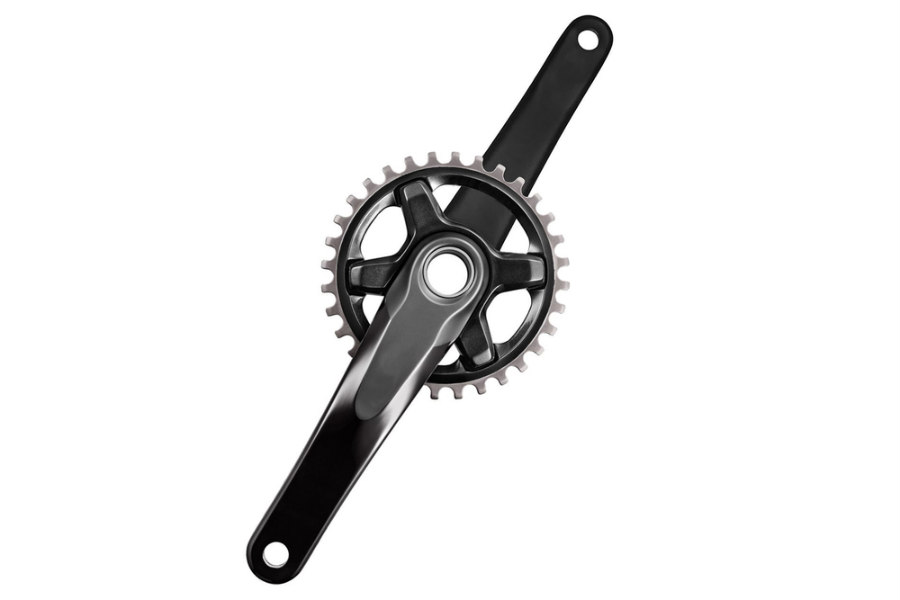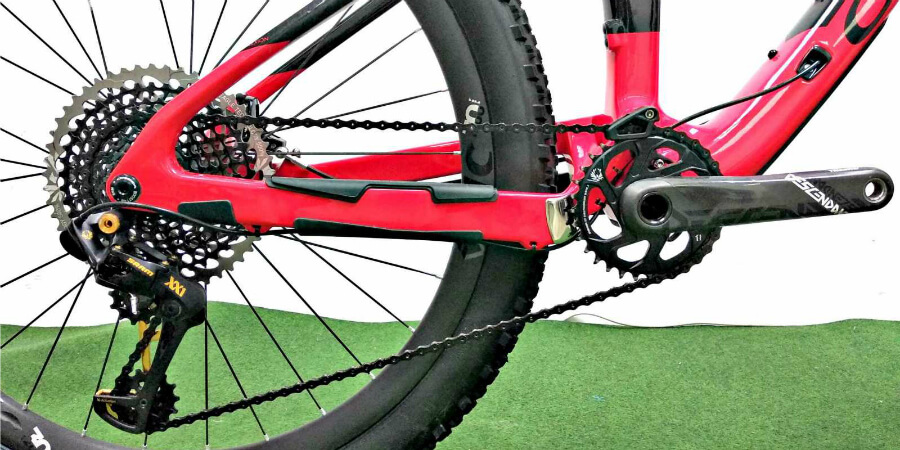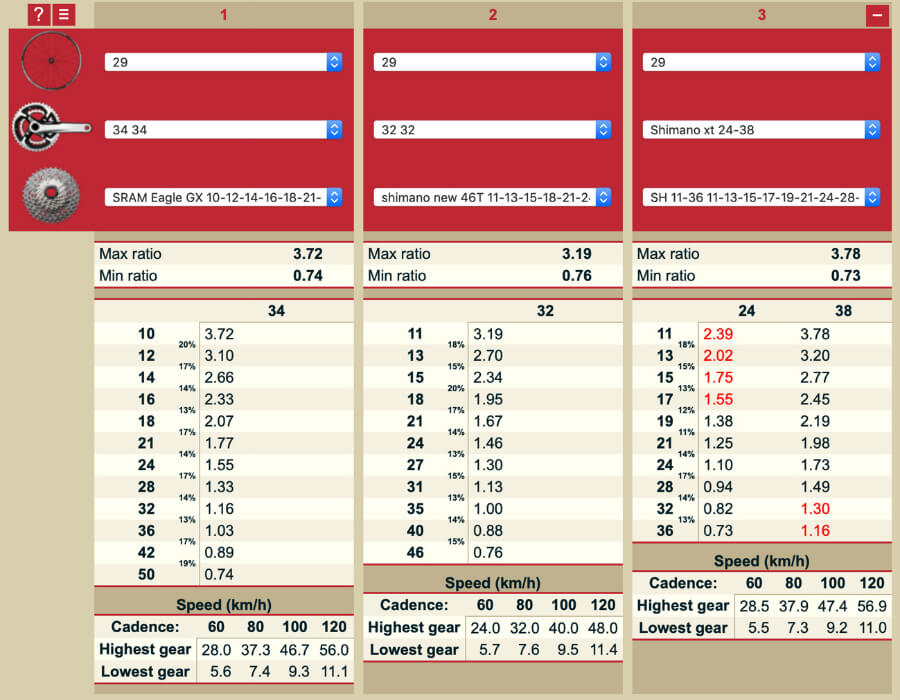In the 1990s the war of speeds in cycling began. At that time who had a bicycle with 3x9 transmission was the leader of the group, the most technologically advanced.
The years passed and the 10V piñoneras arrived and, later, the 11V. Nowadays, 11V cassettes are already a standard on road bicycles. But it seems that they have become obsolete in the mountain segment.
And why do it seem that in
Mountain Bike Has the 11 -speed rear changes fall short? It is a consequence of the implementation of one of the greatest advances of modern cycling, together with the wheels of 29 ": the famous monoplato.
[IRP posts = "1150" name = "seven essential innovations that have changed mountain cycling"]
The arrival of monopathing to Mountain Bike
Before throwing ourselves to talk about transmission relationships, let's comment briefly about the monopath.

The monopath transmissions are born a few years ago as a solution to the demand for simplicity, weight reduction and faults and maintenance of the most active user.
At his birth, the cars faces a serious problem, which although it seems today solved, at that time he doubted many users about its viability. We talked about the 10V piñoneras.
A 10V pañonera (or cassette) began in a pinion (or crown) of 11 teeth and ended in one of 42 teeth. This range is not wide enough for an average user to face high inclinations, and then can reach decent speeds in the plain.
[IRP Posts = "1117" Name = "We analyze the bicycles.
That is why the industry hastened to launch the 11V piñoneras, with an average range in the 11-46V market. That is, a small 11 teeth crown and a top of 46 teeth.

It is worth highlighting two great actors in this market: Sunrace with its 11-46, of the most economical, and Leonardi with its 9-45, which although it was going at a price well above its competitors, gave more rank to the user.
However, the great winner may in this battle (and throughout the war of speeds and monopath) it has been the American SRAM.
His 11V GX change group was and is a supervent. Economic, with a gripshift action fist, now, reliable, and with a robustness that made the user delights more left in the maintenance of their mounts.
The irruption of the changes 12v
SRAM was the transmissions manufacturer that revolutionized the market with its 12 -speed Eagle exchange groups. In a very short time, the industry has already assumed the 1x11 monopathic systems as a standard in practically all the mountain bicycle ranges, including the lowest of the vast majority of brands.

Shimano, the other giant of the exchange groups, has rushed to bring to the market its
Change XTR 12V to try to balance the balance.
But ... why are the 12 speeds necessary now, when the 11V changes had already convinced us? Well, it is simple: due to the lack of progression in the jumps between pinions and, above all, expand the rank of the cassette.
Let's study this point and compare 1x12 with 1x11 and 2x10 most established in the market at all times.
Comparison of developments and conclusions
To make the comparison we have used the MTBXC calculator.
In the lower image we have the following:
- In the first column, the new SRAM Eagle GX with a plate of 34 teeth and pinonera 10-50 teeth. It should be noted that it uses an XD nucleus, not compatible with the vast majority of cassettes. Likewise, the Piñonera GX is cheaper.
- The second column shows the data related to super sales Shimano XT M8000, with a 32-teeth dish and a 11-46 cassette relationship.
- And in the third column, the data of the Shimano XT Biplatum 24-38, with a cassette 11-36. Super sales also at the time (back in 2015).

Analyzing the data, what conclusions can we get on the 1x12 transmission system?
Well, it seems quite obvious than both faster (34x10) and at lower speed (34x50), the 12V 12V SRAM expires by rank to the Shimano XT 11V.
However, the great advantage of 12V is not its greatest rank, but its best progression in the jump between pine nuts (speeds) to 11V and its simplicity when we compare it to the bipe.
We can observe how a clear exponential progression is followed, without speed overlapping, as in the biplatment in relations 24-15 and 38-24, or great losses at the rank extremes as in the case of the XT M8000 (see Highest Gear and Lowest Gear in the graph).
Thus, you only have to try a 1x12 and end up convincing you that the cycling industry, in addition to innovating to generate trade, does so for user satisfaction. And in this case, just as it happened with the 29 ”, he has successful full.
 The monopath transmissions are born a few years ago as a solution to the demand for simplicity, weight reduction and faults and maintenance of the most active user.
At his birth, the cars faces a serious problem, which although it seems today solved, at that time he doubted many users about its viability. We talked about the 10V piñoneras.
A 10V pañonera (or cassette) began in a pinion (or crown) of 11 teeth and ended in one of 42 teeth. This range is not wide enough for an average user to face high inclinations, and then can reach decent speeds in the plain.
[IRP Posts = "1117" Name = "We analyze the bicycles.
That is why the industry hastened to launch the 11V piñoneras, with an average range in the 11-46V market. That is, a small 11 teeth crown and a top of 46 teeth.
The monopath transmissions are born a few years ago as a solution to the demand for simplicity, weight reduction and faults and maintenance of the most active user.
At his birth, the cars faces a serious problem, which although it seems today solved, at that time he doubted many users about its viability. We talked about the 10V piñoneras.
A 10V pañonera (or cassette) began in a pinion (or crown) of 11 teeth and ended in one of 42 teeth. This range is not wide enough for an average user to face high inclinations, and then can reach decent speeds in the plain.
[IRP Posts = "1117" Name = "We analyze the bicycles.
That is why the industry hastened to launch the 11V piñoneras, with an average range in the 11-46V market. That is, a small 11 teeth crown and a top of 46 teeth.
 It is worth highlighting two great actors in this market: Sunrace with its 11-46, of the most economical, and Leonardi with its 9-45, which although it was going at a price well above its competitors, gave more rank to the user.
However, the great winner may in this battle (and throughout the war of speeds and monopath) it has been the American SRAM.
His 11V GX change group was and is a supervent. Economic, with a gripshift action fist, now, reliable, and with a robustness that made the user delights more left in the maintenance of their mounts.
It is worth highlighting two great actors in this market: Sunrace with its 11-46, of the most economical, and Leonardi with its 9-45, which although it was going at a price well above its competitors, gave more rank to the user.
However, the great winner may in this battle (and throughout the war of speeds and monopath) it has been the American SRAM.
His 11V GX change group was and is a supervent. Economic, with a gripshift action fist, now, reliable, and with a robustness that made the user delights more left in the maintenance of their mounts.
 Shimano, the other giant of the exchange groups, has rushed to bring to the market its Change XTR 12V to try to balance the balance.
But ... why are the 12 speeds necessary now, when the 11V changes had already convinced us? Well, it is simple: due to the lack of progression in the jumps between pinions and, above all, expand the rank of the cassette.
Let's study this point and compare 1x12 with 1x11 and 2x10 most established in the market at all times.
Shimano, the other giant of the exchange groups, has rushed to bring to the market its Change XTR 12V to try to balance the balance.
But ... why are the 12 speeds necessary now, when the 11V changes had already convinced us? Well, it is simple: due to the lack of progression in the jumps between pinions and, above all, expand the rank of the cassette.
Let's study this point and compare 1x12 with 1x11 and 2x10 most established in the market at all times.
 Analyzing the data, what conclusions can we get on the 1x12 transmission system?
Well, it seems quite obvious than both faster (34x10) and at lower speed (34x50), the 12V 12V SRAM expires by rank to the Shimano XT 11V.
However, the great advantage of 12V is not its greatest rank, but its best progression in the jump between pine nuts (speeds) to 11V and its simplicity when we compare it to the bipe.
We can observe how a clear exponential progression is followed, without speed overlapping, as in the biplatment in relations 24-15 and 38-24, or great losses at the rank extremes as in the case of the XT M8000 (see Highest Gear and Lowest Gear in the graph).
Thus, you only have to try a 1x12 and end up convincing you that the cycling industry, in addition to innovating to generate trade, does so for user satisfaction. And in this case, just as it happened with the 29 ”, he has successful full.
Analyzing the data, what conclusions can we get on the 1x12 transmission system?
Well, it seems quite obvious than both faster (34x10) and at lower speed (34x50), the 12V 12V SRAM expires by rank to the Shimano XT 11V.
However, the great advantage of 12V is not its greatest rank, but its best progression in the jump between pine nuts (speeds) to 11V and its simplicity when we compare it to the bipe.
We can observe how a clear exponential progression is followed, without speed overlapping, as in the biplatment in relations 24-15 and 38-24, or great losses at the rank extremes as in the case of the XT M8000 (see Highest Gear and Lowest Gear in the graph).
Thus, you only have to try a 1x12 and end up convincing you that the cycling industry, in addition to innovating to generate trade, does so for user satisfaction. And in this case, just as it happened with the 29 ”, he has successful full.












